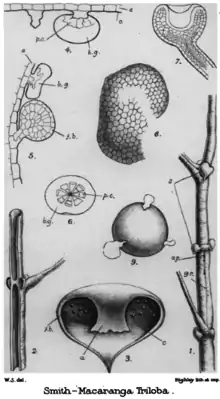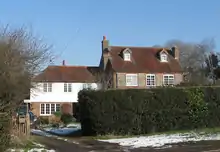Winifred Smith
Winifred Smith (5 November 1858 – 1925) was an English botanist and educationist. She became a lecturer in the botany department at University College, London and took a leading role in supporting women students.
Winifred Smith | |
|---|---|
 Parts of a Macaranga triloba plant drawn by Winifred Smith |
First forty years
She was born in Mortlake, Surrey on 5 November 1858[1] to Fanny and James Smith, who owned and ran a building business.[2][3] Some of Smith's education was at Queen's College, London, a pioneering school for girls aged from 12 to 20. She then "devoted" herself to teaching[4][5] until she began studying at University College in 1899. In the late 1870s her family experienced changes: her father went bankrupt[2] and started working as a clerk, her only sister Ethel married and moved away,[6] and Smith and her parents moved from the long-term family home in Mortlake High Street to live in Putney.[3]
Botany
She received a BSc with honours in botany in 1904. The year before, she had published an article on Macaranga triloba.[7] After getting her degree she did research in symbiosis.[4] In 1905 she was awarded an 1851 Exhibition Scholarship enabling her to study seedling phases of rubber-producing sapotaceae under the direction of John Bretland Farmer.[5][4] She became a Fellow of the Linnaean Society in 1908 and read a paper there on the Anatomy of some Sapotaceous Seedlings which was published in 1909.[8] She was also a member of the British Ecological Society.[1]
University women
Smith's lectureship in botany was not quite as important to her as her "main and absorbing work",[4] from 1912 on, of being Tutor to Women Students. This was a senior post requiring her to offer guidance and support to female students. Her obituaries emphasise what a friendly nature she had and how much people warmed to her.[4][9] She was well known and well liked, and some people spoke of her affectionately as Auntie Winnie.[10] Smith was also vice-chairman of the College Hall of Residence for women students[11] and involved in a range of college activities, women's societies and causes.[4] She was living with her mother in Marylebone in 1901 and 1911.[3]

She was a friend of Margaret Murray, assistant professor of egyptology at University College. Both were committed to women's education,[12] both supported women's suffrage, and both "detested that the women members of the academic staff were treated as second-class citizens".[13] They did not want the women academics to be limited to a cramped, inadequate common room and planned a way of making the decision-makers take note of how much more space and comfort the men had. As Murray said, "Winifred Smith...and I cooked up a little scheme to get our way".[14] They succeeded.
After her death on 24 December 1925, a Winifred Smith Memorial trust fund, announced in The Times,[11] was set up in her honour. The plan was to buy a cottage near her old farmhouse at Chiddingly, Sussex[15] for the benefit of women students and members of staff: for holidays etc. The fund was enlarged by a bequest from the recent University College provost Sir Gregory Foster to commemorate his wife Maude as well as Smith, and so the college came to own two adjoining houses, Old Forge Cottage and Sunnyside in Muddle Green.[16] This arrangement now takes the form of the Winifred Smith and Maude Foster Memorial Fund.[17]
References
- Marilyn Bailey Ogilvie and Joy Harvey, The Biographical Dictionary of Women in Science: L-Z, Taylor and Francis, 2000
- London Gazette, 5 Dec 1879
- Censuses
- Obituary, The Times, 11 January 1926 p16
- Journal of Botany, vol 64, 1926
- Pall Mall Gazette 25 July 1878
- Macaranga Triloba: A New Myrmecophilous Plant, New Phytologist, vol 2, 1903
- The Anatomy of some Sapotaceous Seedlings, Transactions of the Linnean Society of London, 2nd Series: Botany, 7: pp189–200
- Journal of Ecology February 1926
- Hugh Hale Bellot, University College, London, 1826–1926, University of London Press, 1929
- The Times, 9 June 1926 p10
- Sheppard, The Life of Margaret Alice Murray: A Woman’s Work in Archaeology, Lexington 2013
- Cohen and Joukowsky, Breaking Ground: Pioneering Women Archaeologists, University of Michigan Press, 2006
- Margaret Alice Murray, My First Hundred Years, Kimber 1963
- She owned a London flat too.
- UCL Calendars, 1932 and 1934
- Winifred Smith and Maude Foster Memorial Fund